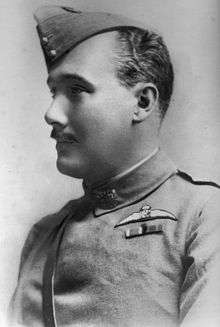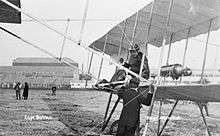Charles Burke (British Army officer)
| Charles James Burke | |
|---|---|
 Burke in the uniform of the Royal Flying Corps | |
| Nickname(s) | Pregnant Percy[1] |
| Born | 1881 or 82 |
| Died |
9 April 1917 Near Arras, France |
| Allegiance |
|
| Service/branch | British Army |
| Rank | Lieutenant-Colonel |
| Unit |
Royal Irish Regiment Royal Flying Corps |
| Battles/wars |
Boer War World War I |
| Awards | Distinguished Service Order |
Lieutenant-Colonel Charles James Burke[2] DSO (1881 or 82 – 9 April 1917) was an officer in the Royal Irish Regiment[3] and the Royal Flying Corps and a military aviation pioneer. He was both the first commander of No. 2 Squadron and later the Second Wing.
Charles Burke was born in 1881 or 1882 and he was the youngest son of the Mr M C C Burke of Ballinhone House, Armagh, Ireland.[4]
Military service before World War I
Burke's military service began as a soldier in the British Army and he served in the Boer War during which time he received the Queen's medal with two clasps.[4] In 1902, at the end of the War, he was commissioned into the Royal Irish Regiment and after several years of regimental service, including three years with the West African Frontier Force,[4] he was promoted to captain in September 1909. The following year Burke travelled to France where he learned to fly in a Farman biplane, gaining his Aéro-Club de France certificate in the process.[5]
After his return to England, Burke was employed at the Army's Balloon School.[5][6] In early 1911, Burke was involved in conducting heavier-than-air aircraft tests at the Balloon Factory. On 7 January 1911 Burke flew a Farman aircraft for two miles over Laffan's Plain at 50 to 80 feet and landed near the Balloon Factory. A few minutes later, Burke attempted a second flight. However, after only 50 yards he stalled and the aircraft came to earth on its right wing, cart-wheeled and disintegrated. Burke received injuries in the crash.[7] Despite this experience, Burke was not deterred from flying. In July of the same year, he flew from Salisbury Plain to Aldershot and back and later on he made a return flight to Oxford.[8]
Burke was also one of the earliest British Army officers to consider air power in depth. In 1911, whilst serving as a captain in the Air Battalion, Burke wrote the first air power article to be published in the Royal United Services Institute Journal. In his article Burke compared the reconnaissance activities of cavalry to those of aircraft and observed that just as opposing cavalry might be drawn into battle, so could aircraft.[9]
In 1912 Burke wrote his 29 maxims for flying, including:[10]
| “ | When training pilots, no machine should go without knowing what it is to do, do it and it alone, then land. | ” |

On 13 May 1912, Burke became the commanding officer of the Flying Corps' No. 2 Squadron and was promoted to major.[11] During the next two years, Burke trained his squadron in aerial reconnaissance.[12] In September 1912, Burke took part in the Army Manoeuvres. Burke was responsible for the control of nine aircraft under the direction of Major Frederick Sykes.[13]
On 13 February 1913, Burke lead five aircraft of No. 2 Squadron from their base at RAE Farnborough, 450 miles (720 km) north in a series of stages over the following 13 days. The aircraft landing at Upper Dysart Farm on 26 February, 3 miles (4.8 km) south of Montrose, Forfarshire, Scotland thus making it the first military airbase to be established in the United Kingdom.[14]
World War I
Burke (as a brevet major) was mentioned in Sir John French’s despatch on 8 October 1914. The following month, on 29 November 1914, Burke was appointed the first commanding officer of No. 2 Wing of the Royal Flying Corps and he set up his headquarters at Saint-Omer. His wing comprised Nos 5 and 6 Squadrons.[15] In 1915 Burke was involved in recruiting for the Royal Flying Corps in Canada. As well as directly recruiting personnel, Burke suggested that training aerodromes might be established in Canada under British control.[16] From February[17] to June 1916,[18] Burke served as the Commandant of the Central Flying School.[19]
In the summer of 1916 Burke rejoined his old regiment, the Royal Irish Regiment, which was suffering a severe shortage of officers. He was killed in action on 9 April 1917, the first day of the Battle of Arras.[5][20] He had been commanding a battalion of the East Lancashire Regiment.[4]
References
- ↑ Van der Spuy, Kenneth Reid (1966). Chasing the Wind. Books of Africa. p. 55.
- ↑ Haffenden, John (2005). "A horrid little boy, airing my views". William Empson: Among the Mandarins. Oxford University Press. p. 41. ISBN 0-19-927659-5. Retrieved 2007-11-10.
- ↑ "Om Royal Flying Corps i 1914, Del 2". Chakoten - Dansk Militærhistorisk Selskab (in Danish). Retrieved 2007-11-10.
- 1 2 3 4 "Personals". Flight. IX (16): 375. 19 April 1917. Retrieved 2009-01-05.
- 1 2 3 Raleigh, Sir Walter Alexander; Jones, Henry Albert (1922). The war in the air; being the story of the part played in the Great War by the Royal Air Force. Oxford Clarendon Press. pp. 251 to 252.
- ↑ "May 1912 - Major G J Burke". II(AC) Sqn Association Web Site. Archived from the original on 1 August 2015. Retrieved 2008-08-14.
- ↑ Jenkins, Garry (2000). Colonel Cody and the Flying Cathedral. New York: Picador USA. ISBN 978-0-312-24180-3.
- ↑ Turner, Charles Cyril (1972) [1927]. "Government and Flying". The Old Flying Days. Ayer Publishing. p. 297. ISBN 0-405-03783-X. Retrieved 2007-11-10.
- ↑ Mason, Tony (2000). "Rethinking the Conceptual Framework". In Peter W Gray. Air Power 21 - Challenges for the New Century. The Stationery Office. p. 229. ISBN 0-11-772960-4.
- ↑ Jupp, John (2005) [2005]. "4 Leadership in the Air (The Art of Leadership in the Air)". In Jupp, John. Air Force Leadership - Beyond Command? (pdf). Grint, Keith. Royal Air Force Leadership Centre. p. 74. ISBN 0-9552189-0-X.
- ↑ The London Gazette: no. 28627. p. 5182. 16 July 1912.
- ↑ "II (AC) Squadron History WWI". Royal Air Force web site. Royal Air Force. 2006. Retrieved 2007-11-10.
- ↑ "British Notes of the Week - Air Work at the Army Manoeuvres". Flight. IV (35): 802. 31 August 1912. Retrieved 2007-11-10.
- ↑ "Montrose air station, the UK's first airbase, marks centenary". BBC News. 23 February 2013. Retrieved 23 February 2013.
- ↑ Dye, Peter (15 September 2003). "British Air Services Memorial St Omer". RAF Personnel and Training Command website. Retrieved 2007-11-10.
- ↑ Heide, Rachel Lea (2 November 2002). "The Struggle to Define and Integrate Alliance Commitments and National Sovereignty in Canada: Lessons from Air Training Plan Negotiations in the First and Second World Wars". Archived from the original on 23 February 2005. Retrieved 2007-11-11.
- ↑ http://www.flightglobal.com/pdfarchive/view/1916/1916%20-%200134.html
- ↑ https://www.thegazette.co.uk/London/issue/29678/supplement/7324/data.pdf
- ↑ Barrass, Malcolm (2007-09-25). "Other Establishments - Flying Schools and Colleges". Air of Authority - A History of RAF Organisation. Retrieved 2007-10-11.
- ↑ CWGC entry
External links
| Wikimedia Commons has media related to Charles Burke (British Army officer). |
| Military offices | ||
|---|---|---|
| New title Post created |
Officer Commanding No. 2 Squadron 13 May 1912 – 10 November 1914 |
Succeeded by G W P Dawes |
| New title Wing established |
Officer Commanding 2nd Wing 29 November 1914 – August 1915 |
Succeeded by J M Salmond |
| Preceded by D le G Pitcher |
Commandant of the Central Flying School 1 February - 18 June 1916 |
Succeeded by A C H MacLean |